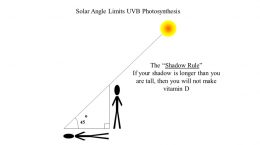Published on April 30, 2022
The sun provides so much for our health, its full benefits cannot be replaced by a vitamin D supplement. Introducing Sunshine Month 2022! Here is what you will learn this May…
Key Points
- Many individuals in today’s modern day society avoid exposure to the sun, covering up 24/7, hiding away from its rays, and failing to include safe and moderate sun exposure as part of a normal, healthy routine; this failure to acknowledge the health benefits of the sun has lead to an epidemic of health consequences resulting from “sunshine deficiency”
- Sunshine exposure has many health benefits beyond vitamin D production, and while vitamin D supplements can partially make up for inadequate sun exposure, no supplement can replace all the benefits provided by sunshine
- The healing ability of the sun, which will be discussed in detail this month, is a powerful reminder of the important roles sunshine plays in human health and the fact that sunshine should not be totally avoided. How can you use the sunshine to benefit your health? Stay tuned to learn much more this May for Sunshine Month!
 Life on earth is brought to you by…. Sunshine! And May is the month to learn about and celebrate all that the sun has to offer.
Life on earth is brought to you by…. Sunshine! And May is the month to learn about and celebrate all that the sun has to offer.
It is because of our perfect distance from the sun (known as the “Goldilocks Zone”) that Earth is able to sustain all life as it is. Any closer to the sun, and it would be too hot – any further away, too cold. It’s a simple explanation, yet the consequences are life-sustaining.
Sunshine is what provides our planet with the ability to hold water, grow plants, and allow humans and other animals to thrive. Cultures and religions throughout history have acknowledged this concept of sunshine being central to all human life and existence, and eventually, our health. Unfortunately, many individuals in today’s modern day society avoid exposure to the sun, covering up 24/7, hiding away from its rays, and failing to include safe and moderate sun exposure as part of a normal, healthy routine. This failure to acknowledge the health benefits of the sun has lead to an epidemic of health consequences resulting from “sunshine deficiency.”
This Sunshine Month, You Will Learn About:
- The wide range of health benefits provided by sunshine exposure, and the health consequences that result from sunshine deficiency
- What each wavelength of energy provided by the sun does for our bodies and our health
- How to maximize the benefits and minimize the harms of sun exposure
- Indoor options to consider (such as sunbeds and sun lights) when the sunshine is not available
- How to make vitamin D from sunlight (and other options)
- How vitamin D and other nutrients help protect the skin from sun damage
- A historical perspective of how the sunshine has been used to benefit our health
Key Point: Vitamin D is Just One of the MANY Health Benefits Provided by Sunshine Exposure
While we now know that there are many benefits to proper sun exposure, the one with the greatest impact is most likely the production of vitamin D, and the reason it is dubbed the “sunshine vitamin.” It is important to remember, however, that sunshine has many health benefits beyond vitamin D production, and while vitamin D supplements can partially make up for inadequate sun exposure, no supplement can replace all the benefits provided by sunshine.
For example, exposure to the sun helps the body to produce other important chemicals and nutrients, such as nitric oxide, melatonin, serotonin, and beta-endorphins; it helps regulate our circadian rhythm (or our body’s “master clock”) and it even has a positive effect on the microbes that live on our skin and in our gut. Even the vitamin D that our body makes in the skin upon exposure to UVB has slightly different benefits than the vitamin D we receive from supplements or diet.
The healing ability of the sun, which will be discussed in detail this month, is a powerful reminder of the important roles sunshine plays in human health and the fact that sunshine should not be totally avoided. So, how can you use the sunshine to benefit your health? What amount is right for you?
For a quick and fun introduction to the full health benefits of the sun, watch the video below!
The Vitamin D Level is a Marker for Sun Exposure
The body is designed to produce vitamin D in the skin upon exposure to UVB radiation. The vitamin D level is therefore often used as a measurement for sun exposure, and especially for those who don’t supplement with vitamin D, a vitamin D deficiency can also indicate “sunshine deficiency.”
If given the chance, the body produces enough vitamin D from sunshine to reach levels of 40-60 ng/ml (100-150 nmol/L), which is also the range recommended by the GrassrootsHealth scientists’ panel. These are the levels naturally achieved by people living traditional lifestyles in Africa and by individuals who work outdoor, such as southern California lifeguards. Vitamin D status can heavily influence how many diseases progress, the chances of survival, and even getting the disease in the first place. Thousands of studies have been completed showing the benefits of maintaining vitamin D levels within this range, from a reduced risk of cardiovascular diseases and autoimmune diseases, to a lower incidence of many forms of cancer. Examples of the effect of vitamin D status on disease risk can be seen in our Disease Incidence Prevention Charts for both general health and pregnancy and childhood.
Start by Making Sure You are Getting Enough Vitamin D TODAY!
 Having and maintaining healthy vitamin D levels and other nutrient levels can help improve your health now and for your future. Choose which additional nutrients to measure, such as your omega-3s and essential minerals including magnesium and zinc, by creating your custom home test kit today. Take steps to improve the status of each of these measurements to benefit your overall health. With measurement you can then determine how much is needed and steps to achieve your goals. You can also track your own intakes, symptoms and results to see what works best for YOU.
Having and maintaining healthy vitamin D levels and other nutrient levels can help improve your health now and for your future. Choose which additional nutrients to measure, such as your omega-3s and essential minerals including magnesium and zinc, by creating your custom home test kit today. Take steps to improve the status of each of these measurements to benefit your overall health. With measurement you can then determine how much is needed and steps to achieve your goals. You can also track your own intakes, symptoms and results to see what works best for YOU.
Enroll in D*action and Test Your Levels Today!





